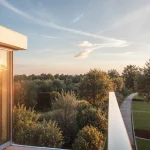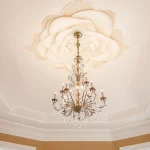Understanding Thatched Roofs
Thatched roofs are a blend of traditional craftsmanship and natural materials, offering both aesthetic appeal and practicality. Commonly made from water reed, straw, or heather, these materials are selected for their durability and waterproof qualities. The choice of thatched roof materials not only affects appearance but also structural integrity. Ensuring compliance with building codes is crucial for safety and longevity.
Structural integrity is central to the process, hinging on smart design and proper installation, preventing issues like leaks or collapses. Building codes dictate standards, ensuring thatched roofs can handle weather conditions and settle harmoniously within their architectural environment.
Also to discover : Transform your home with stunning georgian ceiling roses
Beyond function, thatched roofs hold aesthetic value and are celebrated for their rustic charm. In the UK countryside, they represent rich cultural heritage and history, enhancing property allure and often contributing to increased property values. These roofs integrate seamlessly into natural landscapes, providing an idyllic and picturesque setting.
In summary, a thatched roof combines beauty, functionality, and tradition, adhering to key standards for structural soundness, while contributing a unique aesthetic to the countryside’s architectural tapestry.
Also to discover : Ultimate guide to converting a uk barn into a chic and comfortable home retreat
Regular Maintenance Practices
Regular roof upkeep can effectively prolong a thatched roof’s lifespan. It starts with using the right tools, like soft brushes or leaf blowers, to ensure that cleaning doesn’t damage the thatching materials. Equipping yourself with supplies designed for gentle handling is crucial.
Maintenance frequency varies based on environmental conditions. However, it is generally recommended to inspect the roof every six months. During these checks, look for signs of wear or potential damage. Additionally, a yearly professional assessment can further ensure the roof’s integrity.
Effective cleaning techniques focus on gently removing debris and moss, which could retain moisture and lead to rot. Employ a soft brush to gently sweep the surface, taking care not to disturb the tightly packed straw or reed. For more stubborn moss, professional-grade treatments can be applied by experts to prevent damage.
Adhering to these maintenance practices not only preserves the structural integrity of the roof but also sustains its aesthetic value. A well-kept roof not only contributes to property charm but can also enhance its longevity, making it a worthwhile investment.
Identifying Common Issues
When dealing with thatched roofs, understanding potential roof problems and the health of the thatching is crucial. Regular intuitiveness helps prevent escalating issues. Here’s a closer look at common complications and how to address them:
Leaks and Water Damage
Leaks are a serious concern, often signified by damp patches or staining. Check your roof after heavy rainfall to catch issues early.
Pest Infestations
Pests, like birds nesting within the thatching, can compromise a roof’s durability. Pest presence might be detected through visible debris or excessive noise.
Wear and Tear
Over time, natural wear and tear lead to visible signs such as thinning surfaces or discolouration. Regular assessments provide insight into the extent of wear, enabling timely repairs and maintenance to avoid structural integrity loss.
A keen eye for these issues, coupled with prompt action, ensures the ongoing health of thatching. By taking proactive steps, you preserve the longevity and beauty of your thatched roof, safeguarding your investment and maintaining property’s charm.
Expert Tips for Long-term Care
Ensuring the longevity of a thatched roof requires insights from thatching experts. They recommend regular, thorough inspections both by homeowners and professionals to spot early signs of potential issues. Professional advice highlights the importance of using high-quality thatched roof materials, as lower-grade fibers may compromise the structure over time.
Interviews with seasoned thatchers reveal that preventative measures, such as timely re-thatching and minor repairs, can significantly extend a roof’s life. These experts also suggest using natural deterrents to prevent pest infestations and integrating modern waterproofing solutions without sacrificing the roof’s historical charm.
Case studies show that properties with well-maintained thatched roofs not only boast enhanced aesthetic value but also tend to better withstand environmental stresses. Conversely, neglected roofs commonly face structural degradation and higher long-term costs. Owners can learn valuable lessons from these examples, underscoring the need for strategic maintenance planning.
Incorporating these expert recommendations can ensure thatched roofs remain robust, beautiful, and historically significant while securing strong investment returns over time. By embracing suggested practices, homeowners can adeptly navigate the complexities of caring for such unique architectural features.
Local Regulations and Best Practices
When dealing with thatched roofs in the UK, understanding local building regulations and conservation guidelines is vital. These regulations ensure that renovations and repairs preserve the cultural heritage embodied in traditional structures. Compliance with these laws not only protects architectural history but also helps avoid potential legal issues.
Navigating local laws can seem daunting, but numerous resources for homeowners exist. For example, local councils often provide guidance on conservation areas, highlighting any restrictions on materials or design alterations. Consulting with authorities before starting any project is crucial to align with conservation goals.
Moreover, understanding how regulations contribute to cultural significance aids in appreciating a thatched roof’s aesthetic value. By maintaining architectural authenticity, communities carry forward their heritage, enhancing a sense of belonging and continuity with the past.
In essence, best practices don’t only focus on adherence to regulations but also involve proactive engagement with these resources. Homeowners are encouraged to seek expert advice and local insights to ensure their properties harmoniously blend tradition with modern living, elevating both property charm and community heritage.
Budgeting for Maintenance and Repairs
Navigating the financial landscape of maintaining a thatched roof involves careful planning and cost considerations. Understanding the typical expenses involved in upkeep, repairs, and unforeseen issues is crucial for homeowners. On average, maintaining a thatched roof can range from £700 to £1,500 annually, depending on factors like roof size and location.
Budgeting tips involve setting aside a yearly maintenance fund, which helps manage regular tasks and address unexpected issues. Allocating around 10% of your initial installation cost annually can extend the roof’s life significantly. Consider creating a savings buffer for emergencies, which helps mitigate sudden expenses like pest infestations or storm damage.
Choosing reliable service providers and suppliers is vital. Seek recommendations from local councils or thatching guilds for trusted professionals who adhere to industry standards. Enquire about their experience and client testimonials, ensuring quality service and fair pricing.
By focusing on these budgetary aspects, homeowners can effectively plan for long-term care and preservation, keeping their thatched roofs not only beautiful but also structurally sound.
Conclusion
In our ultimate guide to maintaining thatched roofs, we’ve delved into various aspects into ensuring their longevity and historical appeal. Emphasising thatched roof care, the discussion has highlighted essential practices, such as regular maintenance routines, material quality, and professional services. By implementing strategic approaches, property owners can merge tradition with modern living, ultimately enhancing property preservation.
Acknowledging local regulations and cultural significance contributes to the comprehensive approach needed for optimal maintenance. Embracing these insights not only conserves the roof’s structural and aesthetic integrity but also preserves a rich heritage that adds immense value to properties. Recognising the importance of cost-effective measures and strategic planning ensures these roofs remain both beautiful and robust over time.
In essence, the informed understanding of thatched roof care fosters appreciation for this architectural feature, supporting both the structural integrity and aesthetic allure it brings to landscapes and communities. By integrating expert tips and local knowledge, homeowners are well-equipped to maintain these historically significant structures and enjoy their charm for generations.










